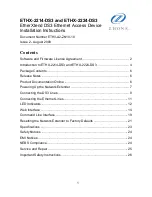
Table 8-12
Preemption mode
Preemption
Mode
Advantage
Disadvantage
Non-preemption
mode
SEP is in non-
preemption mode by
default.
In this mode, blocking an
interface does not
disconnect any link in a
SEP segment.
The blocked interface is one of the two
interfaces that complete neighbor
negotiations last.
Preempt
ion
mode
Delayed
preempt
ion
Each time a fault is
rectified, the system
automatically completes
preemption and ensures
that the specified
interface is blocked.
l
The delayed preemption mode needs to
be specified in advance. There is no
default delay in preemption, and the
delay time needs to be configured using
a command.
l
After delayed preemption is configured
successfully, a fault needs to be
simulated to ensure that the specified
interface is blocked.
Manual
preempt
ion
Whether the specified
interface will be blocked
can be controlled
manually.
l
The manual preemption mode needs to
be specified in advance.
l
After a network fault is rectified and the
preemption action is taken, manual
preemption no longer takes effect.
Manual preemption needs to be
configured again to ensure that the
blocked point can be moved to the
specified point after the next fault is
rectified. This increases the
maintenance workload.
The following conditions must be met to trigger preemption:
l
The SEP segment topology is complete.
l
The primary edge interface or no-neighbor primary edge interface has been elected in the
SEP segment.
l
The function of flexibly specifying a blocked interface is enabled on the device where the
primary edge interface or no-neighbor primary edge interface resides.
Perform the following operations on the Layer 2 switching device where the primary edge
interface or no-neighbor primary edge interface resides.
Procedure
Step 1
Run:
system-view
Huawei AR530&AR550 Series Industrial Switch Routers
Configuration Guide - Ethernet Switching
8 SEP Configuration
Issue 01 (2014-11-30)
Huawei Proprietary and Confidential
Copyright © Huawei Technologies Co., Ltd.
308
















































